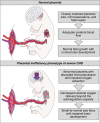Neuroplacentology in congenital heart disease: placental connections to neurodevelopmental outcomes
- PMID: 33864014
- PMCID: PMC9064799
- DOI: 10.1038/s41390-021-01521-7
Neuroplacentology in congenital heart disease: placental connections to neurodevelopmental outcomes
Abstract
Children with congenital heart disease (CHD) are living longer due to effective medical and surgical management. However, the majority have neurodevelopmental delays or disorders. The role of the placenta in fetal brain development is unclear and is the focus of an emerging field known as neuroplacentology. In this review, we summarize neurodevelopmental outcomes in CHD and their brain imaging correlates both in utero and postnatally. We review differences in the structure and function of the placenta in pregnancies complicated by fetal CHD and introduce the concept of a placental inefficiency phenotype that occurs in severe forms of fetal CHD, characterized by a myriad of pathologies. We propose that in CHD placental dysfunction contributes to decreased fetal cerebral oxygen delivery resulting in poor brain growth, brain abnormalities, and impaired neurodevelopment. We conclude the review with key areas for future research in neuroplacentology in the fetal CHD population, including (1) differences in structure and function of the CHD placenta, (2) modifiable and nonmodifiable factors that impact the hemodynamic balance between placental and cerebral circulations, (3) interventions to improve placental function and protect brain development in utero, and (4) the role of genetic and epigenetic influences on the placenta-heart-brain connection. IMPACT: Neuroplacentology seeks to understand placental connections to fetal brain development. In fetuses with CHD, brain growth abnormalities begin in utero. Placental microstructure as well as perfusion and function are abnormal in fetal CHD.
© 2021. The Author(s).
Conflict of interest statement
The authors declare no competing interests.
Figures


Similar articles
-
Placental Pathology Contributes to Impaired Volumetric Brain Development in Neonates With Congenital Heart Disease.J Am Heart Assoc. 2024 Mar 5;13(5):e033189. doi: 10.1161/JAHA.123.033189. Epub 2024 Feb 29. J Am Heart Assoc. 2024. PMID: 38420785 Free PMC article.
-
Placental vascular malperfusion lesions in fetal congenital heart disease.Am J Obstet Gynecol. 2022 Oct;227(4):620.e1-620.e8. doi: 10.1016/j.ajog.2022.05.038. Epub 2022 May 21. Am J Obstet Gynecol. 2022. PMID: 35609643
-
Placenta morphology and biomarkers in pregnancies with congenital heart disease - A systematic review.Placenta. 2021 Sep 1;112:189-196. doi: 10.1016/j.placenta.2021.07.297. Epub 2021 Aug 8. Placenta. 2021. PMID: 34388551
-
3-D volumetric MRI evaluation of the placenta in fetuses with complex congenital heart disease.Placenta. 2015 Sep;36(9):1024-30. doi: 10.1016/j.placenta.2015.06.013. Epub 2015 Jul 6. Placenta. 2015. PMID: 26190037 Free PMC article.
-
Shared developmental pathways of the placenta and fetal heart.Placenta. 2023 Sep 26;141:35-42. doi: 10.1016/j.placenta.2022.12.006. Epub 2022 Dec 27. Placenta. 2023. PMID: 36604258 Review.
Cited by
-
Fetal origin of brain dysmaturation in congenital heart disease - Challenges and opportunities for interventions.J Neonatal Perinatal Med. 2022;15(3):489-494. doi: 10.3233/NPM-210942. J Neonatal Perinatal Med. 2022. PMID: 35034913 Free PMC article. No abstract available.
-
Placenta: an old organ with new functions.Front Immunol. 2024 Apr 19;15:1385762. doi: 10.3389/fimmu.2024.1385762. eCollection 2024. Front Immunol. 2024. PMID: 38707901 Free PMC article. Review.
-
Placenta-Heart-Brain Connection in Congenital Heart Disease.J Am Heart Assoc. 2024 Mar 5;13(5):e033875. doi: 10.1161/JAHA.124.033875. Epub 2024 Feb 29. J Am Heart Assoc. 2024. PMID: 38420776 Free PMC article. No abstract available.
-
Associations between Maternal Risk Factors and Intrinsic Placental and Fetal Brain Functional Properties in Congenital Heart Disease.Int J Mol Sci. 2022 Dec 2;23(23):15178. doi: 10.3390/ijms232315178. Int J Mol Sci. 2022. PMID: 36499505 Free PMC article.
-
Prenatal Diagnosis of Congenital Heart Diseases and Associations with Serum Biomarkers of Aneuploidy: A Multicenter Prospective Cohort Study.Yonsei Med J. 2022 Aug;63(8):735-743. doi: 10.3349/ymj.2022.63.8.735. Yonsei Med J. 2022. PMID: 35914755 Free PMC article.
References
-
- Hoffman JI, Kaplan S. The incidence of congenital heart disease. J. Am. Coll. Cardiol. 2002;39:1890–1900. - PubMed
-
- Marino BS, et al. Neurodevelopmental outcomes in children with congenital heart disease: evaluation and management: a scientific statement from the American Heart Association. Circulation. 2012;126:1143–1172. - PubMed
-
- Albalawi A, et al. Placental characteristics of fetuses with congenital heart disease. J. Ultrasound Med. 2017;36:965–972. - PubMed
Publication types
MeSH terms
LinkOut - more resources
Full Text Sources
Other Literature Sources
Medical

